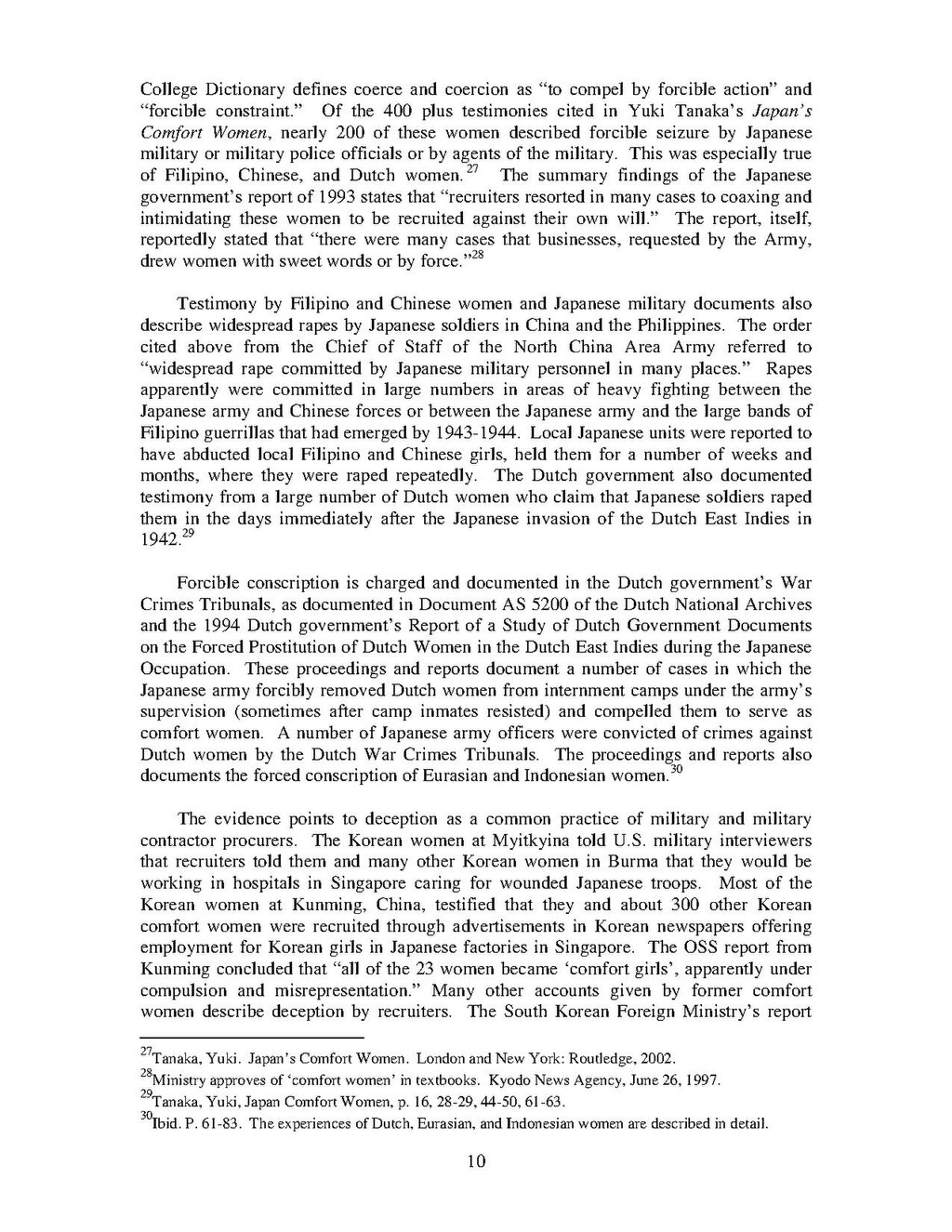College Dictionary defines coerce and coercion as “to compel by forcible action” and “forcible constraint.” Of the 400 plus testimonies cited in Yuki Tanaka’s Japan’s Comfort Women, nearly 200 of these women described forcible seizure by Japanese military or military police officials or by agents of the military. This was especially true of Filipino, Chinese, and Dutch women.[1] The summary findings of the Japanese government’s report of 1993 states that “recruiters resorted in many cases to coaxing and intimidating these women to be recruited against their own will.” The report, itself, reportedly stated that “there were many cases that businesses, requested by the Army, drew women with sweet words or by force.”[2]
Testimony by Filipino and Chinese women and Japanese military documents also describe widespread rapes by Japanese soldiers in China and the Philippines. The order cited above from the Chief of Staff of the North China Area Army referred to “widespread rape committed by Japanese military personnel in many places.” Rapes apparently were committed in large numbers in areas of heavy fighting between the Japanese army and Chinese forces or between the Japanese army and the large bands of Filipino guerrillas that had emerged by 1943–1944. Local Japanese units were reported to have abducted local Filipino and Chinese girls, held them for a number of weeks and months, where they were raped repeatedly. The Dutch government also documented testimony from a large number of Dutch women who claim that Japanese soldiers raped them in the days immediately after the Japanese invasion of the Dutch East Indies in 1942.[3]
Forcible conscription is charged and documented in the Dutch government’s War Crimes Tribunals, as documented in Document AS 5200 of the Dutch National Archives and the 1994 Dutch government’s Report of a Study of Dutch Government Documents on the Forced Prostitution of Dutch Women in the Dutch East Indies during the Japanese Occupation. These proceedings and reports document a number of cases in which the Japanese army forcibly removed Dutch women from internment camps under the army’s supervision (sometimes after camp inmates resisted) and compelled them to serve as comfort women. A number of Japanese army officers were convicted of crimes against Dutch women by the Dutch War Crimes Tribunals. The proceedings and reports also documents the forced conscription of Eurasian and Indonesian women.[4]
The evidence points to deception as a common practice of military and military contractor procurers. The Korean women at Myitkyina told U.S. military interviewers that recruiters told them and many other Korean women in Burma that they would be working in hospitals in Singapore caring for wounded Japanese troops. Most of the Korean women at Kunming, China, testified that they and about 300 other Korean comfort women were recruited through advertisements in Korean newspapers offering employment for Korean girls in Japanese factories in Singapore. The OSS report from Kunming concluded that “all of the 23 women became ‘comfort girls’, apparently under compulsion and misrepresentation.” Many other accounts given by former comfort women describe deception by recruiters. The South Korean Foreign Ministry’s report
- ↑ Tanaka, Yuki. Japan’s Comfort Women. London and New York: Routledge, 2002.
- ↑ Ministry approves of ‘comfort women’ in textbooks. Kyodo News Agency, June 26, 1997.
- ↑ Tanaka, Yuki, Japan Comfort Women, p. 16, 28–29, 44–50, 61–63.
- ↑ Ibid. P. 61–83. The experiences of Dutch, Eurasian, and Indonesian women are described in detail.
10
